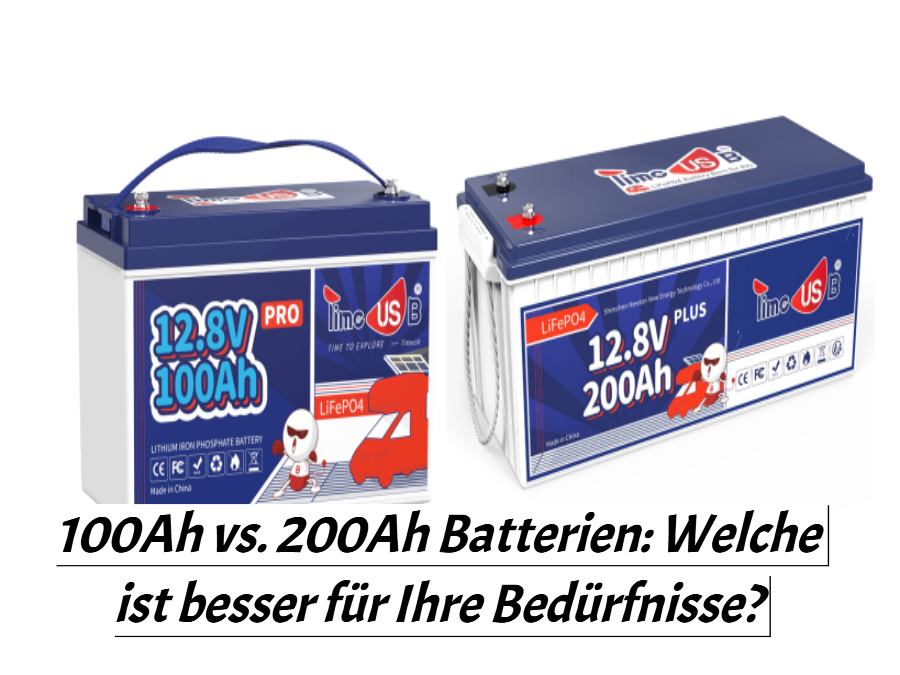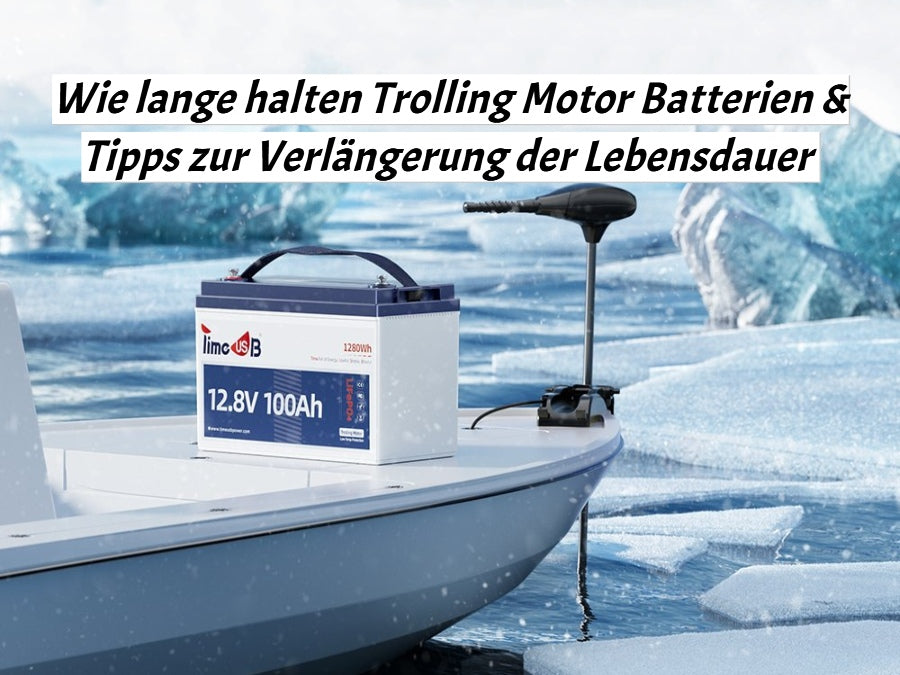[Complete Guide] Comparing the differences between LiFePO4 batteries and Li-ion batteries
![[Vollständiger Leitfaden] Vergleich der Unterschiede zwischen LiFePO4 Akkus und Li-Ionen Batterien](http://timeusbpower.de/cdn/shop/articles/LiFePO4_Akku_Timeusb_Lithiumbatterie_50Ah_Batterie_12V_Solar.jpg?v=1702536258&width=1600)
If you want to power electronic devices, electric cars, off-grid power solutions or medical devices, choosing the right battery is crucial. Two of the most popular types of batteries currently available on the market are LiFePO4 batteries and lithium-ion batteries. In this article, we'll look at the differences and benefits of the two battery types and help you decide which one is best for your needs.
Part 1. LiFePO4 batteries
Lithium iron phosphate batteries (LiFePO4 batteries) are rechargeable lithium-ion batteries that use iron phosphate as the cathode material instead of cobalt, nickel or manganese. They are known for their high safety, long service life and stable performance.
Compared to other lithium-ion batteries, LiFePO4 has a lower energy density but is less susceptible to thermal runaway, a dangerous condition in which the battery overheats and ignites. This makes LiFePO4 batteries ideal for applications where safety is paramount, such as electric vehicles, solar power systems and portable electronic devices.
LiFePO4 batteries have a nominal voltage of 3.2 volts per cell and canconnected in series or parallel to achieve higher voltages or capacities. They can also be charged and discharged with high currents without any significant loss of capacity or performance.
Part 2. Li-ion batteries
Lithium-ion batteries are rechargeable batteries that use lithium ions as the main component of their electrolyte. They are widely used in portable electronic devices, electric vehicles, and other applications that require high energy density, low self-discharge, and long cycle life.
Lithium-ion batteries consist of one or more cells, each containing a positive electrode (cathode), a negative electrode (anode), and an electrolyte that allows the movement of lithium ions between the electrodes during charging and discharging.

One of the key features of lithium-ion batteries is their high energy density, which means they can store a lot of energy in a small volume. This makes them ideal for portable devices and electric vehicles where space is limited. They also have a relatively low self-discharge rate compared to other rechargeable batteries, meaning they can hold a charge for a long period of time without significant loss of capacity.
However, lithium-ion batteries also have some disadvantages. They are sensitive to high temperatures and overcharging, which can cause them to degrade quickly or even catch fire. They also have a limited lifespan, as the number of charge-discharge cycles varies depending on factors such as temperature, depth of discharge and charging voltage.
Part 3. Complete comparison of LiFePO4 and Li-ion batteries
In this part, we will make a comprehensive comparison between LiFePO4 and Li-ion batteries and analyze their differences in aspects such as DOD, voltage, self-discharge rate and more.
depth of discharge (DOD)
When it comes to depth of discharge (DOD), LiFePO4 batteries tend to perform better than lithium-ion batteries. LiFePO4 batteries can be discharged up to 100% without negatively affecting their service life.On the other hand, discharging a lithium-ion battery below the recommended DOD can cause permanent damage to the battery or even render it unusable.
Generally, the recommended DOD for a lithium-ion battery is around 80%, while the recommended DOD for LiFePO4 is typically around 100%. This means that LiFePO4 batteries can provide more usable energy than lithium-ion batteries because they can be fully discharged without damaging the battery. Additionally, this means that you will get more energy from a LiFePO4 battery than from a lithium-ion battery of the same capacity.
However, it is worth noting that a lithium-ion battery can still provide high levels of performance at a lower DOD compared to a LiFePO4 battery. It is important to consider the specific requirements of your application and select a battery accordingly, as both LiFePO4 and lithium-ion batteries have their own unique characteristics and advantages.
voltage
Li-ion and LiFePO4 batteries differ in their nominal voltage values. Li-ion batteries typically have a higher nominal voltage range of 3.6-3.7V per cell, while LiFePO4 batteries have a nominal voltage of around 3.2V per cell, so more cells are required to achieve the same output voltage.
For example, a standard 12V lithium-ion battery only needs 3 or 4 cells connected in series, while a 12V LiFePO4 battery needs 4 or 5 cells to achieve the same voltage level. Although LiFePO4 may result in slightly larger and heavier batteries, it offers several advantages such as greater safety, longer lifespan, and a wider operating temperature range.
It is important to note that although LiFePO4 batteries have a lower nominal voltage than Li-ion batteries, they can deliver a higher discharge current without a significant voltage drop. Due to a lower internal resistance, LiFePO4 batteries can deliver high power output with minimal energy loss.
self-discharge rate
Self-discharge rate is the rate at which a battery loses its charge over time, even when not in use. It is a natural process that occurs in all battery types and can be affected by various factors such as temperature, battery age and storage conditions. A battery with a higher self-discharge rate will lose its charge faster and have a shorter lifespan than a battery with a lower self-discharge rate.
When it comes to self-discharge rate, LiFePO4 batteries have a significantly lower rate compared to Li-ion batteries.
On average, Li-ion batteries lose about 5-10% of their charge per month, while LiFePO4 batteries only lose about 2-3% per month.
This means that Li-ion batteries can lose up to 60% of their charge in one year of storage, while LiFePO4 batteries would only lose about 20-30% in the same period. This makes LiFePO4 batteries much more suitable for applications where long-term storage is required, for example in renewable energy systems or marine applications.
energy density
In general, lithium iron phosphate batteries (LiFePO4 batteries) have a lower energy density than lithium-ion batteries (Li-ion). LiFePO4 batteries have an energy density of about 120–160 Wh/kg, while Li-ion batteries can have an energy density of up to 200–300 Wh/kg or more.
One of the reasons for the lower energy density in LiFePO4 solar batteries is the larger size of their cathode particles, which results in less surface area and fewer active sites for lithium ion storage during charging and discharging. Another reason is the lower voltage of LiFePO4 batteries (3.2V per cell) compared to Li-ion batteries (3.6-3.7V per cell), which means more cells are needed to achieve a given voltage.
Weight
In general, LiFePO4 batteries tend to be slightly heavier than Li-ion batteries for a given energy capacity.
This is because LiFePO4 batteries have a lower energy density than Li-ion batteries, meaning they require more material (such as electrodes, separator, electrolyte, etc.) to store an equivalent amount of energy. In addition, LiFePO4 batteries typically use thicker electrodes and separators, which increases their overall weight.
For example, a typical 12V 100Ah LiFePO4 battery used in electric vehicles or solar power systems may weigh around 30-40kg, while a similar Li-ion battery may weigh around 20-30kg. It should be noted, however, that weight is only one factor to consider when selecting a battery, and that depending on the application, other factors such as safety, cost, lifetime and operating temperature range may also be important.
temperature range
Lithium iron phosphate batteries (LiFePO4 batteries) have a wider temperature range than lithium-ion (Li-ion) batteries. LiFePO4 batteries can typically operate in a temperature range of -20°C to 60°C (-4°F to 140°F), while Li-ion batteries typically operate in a narrower temperature range of -20°C to 45°C (-4°F to 113°F).
One of the reasons for this difference is that LiFePO4 batteries have a more stable chemistry and are less susceptible to thermal runaway, a dangerous condition in which the battery overheats and ignites. This makes LiFePO4 batteries suitable for applications where high temperatures can occur, such as electric vehicles, renewable energy systems and military applications.
In contrast, Li-ion batteries are more sensitive to high temperatures and can deteriorate quickly or even catch fire when exposed to extreme temperatures or conditions. Therefore, Li-ion batteries are typically equipped with thermal management systems such as cooling fans or heat sinks to prevent overheating.
However, it should be noted that the specific temperature range of a battery also depends on other factors such as battery configuration, packaging and operating conditions. In general, both LiFePO4 and Li-ion batteries should be operated within the specified temperature ranges to ensure optimal performance and safety.
life
Lithium iron phosphate batteries (LiFePO4 batteries) have a longer lifespan than lithium-ion (Li-ion) batteries. Li-ion batteries typically have a lifespan of around 500-1500 cycles, while LiFePO4 batteries can typically last up to 2000-5000 cycles. With Class A cells, Timeusb LiFePO4 batteries can last up to 4000-15000 cycles.
One of the reasons for this difference is that LiFePO4 batteries have a more stable chemistry and are less susceptible to degradation during charge and discharge cycles.The LiFePO4 battery The iron phosphate cathode material used is also more resistant to oxidation and corrosion, which helps maintain the battery's capacity and performance over a longer period of time.
In contrast, Li-ion batteries are more sensitive to cycling and can lose capacity over time due to factors such as electrode degradation, electrolyte degradation and internal resistance. This can lead to reduced runtime and performance, especially under high load or extreme temperatures.
However, it should be noted that the specific lifespan of a battery depends on many factors, such as depth of discharge, charging voltage, temperature and usage behavior. In general, both LiFePO4 and Li-ion batteries can function reliably for many years if operated within their specified parameters and properly maintained.
Security
Lithium iron phosphate batteries (LiFePO4 batteries) are generally considered safer than lithium-ion batteries (Li-ion batteries), especially in certain applications where safety is paramount.
One of the reasons for this difference is that LiFePO4 batteries have a more stable and robust chemistry compared to Li-ion batteries. The iron phosphate cathode material used in LiFePO4 batteries is more resistant to thermal runaway, a dangerous condition in which the battery overheats and ignites. This makes LiFePO4 batteries less prone to catching fire or exploding even under extreme conditions such as overcharging, short circuits, or mechanical abuse.
In contrast, Li-ion batteries are more susceptible to Thermal RunawayThermal runaway can cause catastrophic battery failure, releasing toxic gases, flames, and sometimes explosions.
However, it is important to note that both LiFePO4 and Li-ion batteries can be safe when properly designed, manufactured and operated within their specified parameters. Factors such as cell design, packaging, quality control and safety features such as protection circuits and thermal management systems can all play a role in ensuring safe and reliable battery operation.
Cost
Li-ion batteries are generally cheaper and more widely available than LiFePO4 batteries. This cost advantage is due in part to the higher energy density of Li-ion batteries, which allows them to store more energy per unit volume or weight, making them more cost-effective for certain applications.
LiFePO4 batteries, on the other hand, are typically more expensive due to their lower energy density and the use of more expensive materials in their construction. However, LiFePO4 batteries have a longer lifespan and higher safety standards than Li-ion batteries, which can lead to lower long-term costs and lower risk for certain applications such as electric vehicles and renewable energy storage systems.
For example, a Timeusb 12V 200Ah Plus Deep Cycle LiFePO4 Battery 529.99 €, it has more than 4000 cycles at 100% DOD and can be used for more than 10 years, which means less than 2 € per day.
Part 4Application comparison of LiFePO4 and Li-ion batteries
LiFePO4 batteries and Li-ion batteries have different properties that make them more suitable for certain applications. Here is a comparison of the applications for each battery type:
LiFePO4 battery:
Electric vehicles (EVs): LiFePO4 batteries are characterized by high energy efficiency, long service life and excellent safety features, making them a popular choice for electric vehicles.
Solar storage systems: LiFePO4 lithium batteries can withstand high temperatures and deep cycles and are therefore suitable for storing solar energy.
Applications in shipping and mobile homes: LiFePO4 batteries are lightweight, have a long lifespan and are shock and vibration resistant, making them ideal for marine and RV applications.
Li-ion battery:
Consumer Electronics:Li-ion batteries have a high energy density and are therefore ideal for portable electronic devices such as smartphones, laptops and tablets.
Medical devices:Li-ion batteries are used in medical devices due to their high energy density and long service life.
Power tools:Li-ion batteries are lightweight, powerful and can be charged quickly, making them ideal for use in power tools.
Conclusion
Both lithium iron phosphate (LiFePO4) batteries and Li-ion batteries have their own strengths and weaknesses and their suitable applications.
If you need deep-cycle batteries to power your RV, boat or home,Timeusbalways trustworthy batteries and excellent service.




